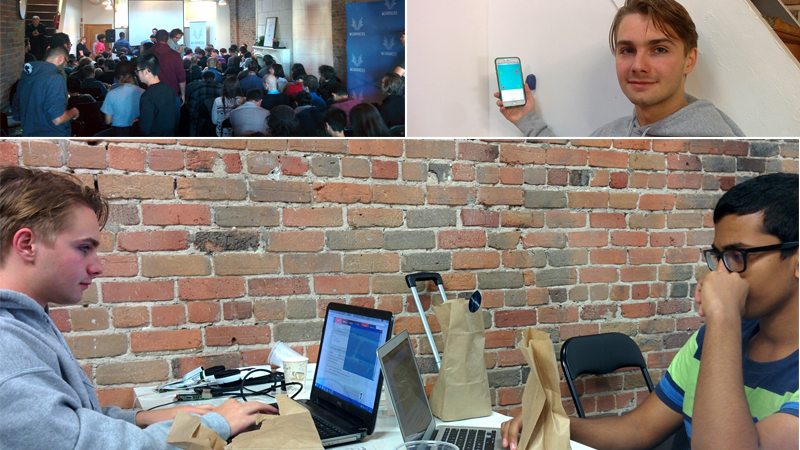
Nov. 2, 2015
Students Nikita Gusev (Year 3 ElecE), Mitchell Au (Year 3 ElecE) and Farhad Yusufali (Year 3 CompE) set out to answer a pressing open question that has plagued engineers for centuries: where’s the party?
The team of undergraduates from The Edward S. Rogers Sr. Department of Electrical & Computer Engineering traveled to Montreal to participate in WearHacks 2015, the biggest hackathon in North America for wearables and Internet of Things hardware.
Their idea was to build a network of smartphones ‘talking to’ Estimote Beacons to produce a map of a large event, such as a music festival or dance party, indicating where people’s heartrates are elevated.
“We envisioned the system for a big venue, where you can’t see the whole space at once, but you want to go where people are having fun,” says Au. “What it looks like is a heat map,” says Gusev.
Users would download an app to their smartphone, and sync it with heartrate-tracking hardware. When you approach one of the beacons scattered throughout the venue, your app sends your location and heartrate information to the server over Wifi. Monitoring the app shows you the real-time heat map of all users’ heartrates.
“We finished—we didn’t have a pretty interface, but the components were all there,” says Gusev. “The next step would be to build it out to handle more beacons and more users at multiple venues, like different places across a city.”
The team that hacks together stays together, and Gusev, Au, Yusufalis and classmate Ivan Radovic have a history of success. Their first hackathon together was for Tetra Society, the organization that aims to create custom assistive devices for people with a wide range of medical conditions. Tetra challenged hackers to create assistive devices for unlocking doors. Gusev, Au and Yousefali channeled what they’d learned about biomimicry in their Engineering Strategies and Practice course to build a long, extendable arm with a gripper on the end that could pinch like chopsticks. Their design won them first prize.
At WearHacks, they leaned on that experience and their problem-solving chops to overcome technical problems during the 48-hour hackathon.
“There’s always that wall that you hit at every hackathon—it’s unavoidable,” says Au.
“I think the best part about it was that the engineering curriculum really teaches you how to tackle problems—you learn how to learn, so that when we got stuck we were always able to come up with something new to try,” says Gusev. “Every time something worked, I thought it was unbelievable. I just can’t believe how good technology is,” added Au.
Although they didn’t finish in the top 10 or win the grand prize, the team would like to continue building on their local-social platform in their own time, and launch a few fresh ideas at future hackathons.
“There’s lots of room to grow this—it could be very big,” says Gusev.
More information:
Marit Mitchell
Senior Communications Officer
The Edward S. Rogers Sr. Department of Electrical & Computer Engineering
416-978-7997; marit.mitchell@utoronto.ca